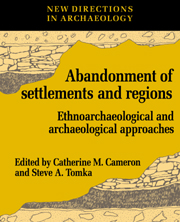Book contents
- Frontmatter
- Contents
- List of figures
- List of tables
- List of contributors
- Acknowledgments
- PART I INTRODUCTION
- PART II REGIONAL ABANDONMENT PROCESSES: ETHNOARCHAEOLOGICAL CASES
- PART III REGIONAL ABANDONMENT PROCESSES: ARCHAEOLOGICAL CASES
- PART IV ABANDONMENT PROCESSES WITHIN SITES: ETHNOARCHAEOLOGICAL CASES
- 10 Abandonment at Zuni farming villages
- 11 Abandonment and the production of archaeological variability at domestic sites
- PART V ABANDONMENT PROCESSES WITHIN SITES: ARCHAEOLOGICAL CASES
- PART VI CONCLUSIONS
- Index
10 - Abandonment at Zuni farming villages
Published online by Cambridge University Press: 23 May 2010
- Frontmatter
- Contents
- List of figures
- List of tables
- List of contributors
- Acknowledgments
- PART I INTRODUCTION
- PART II REGIONAL ABANDONMENT PROCESSES: ETHNOARCHAEOLOGICAL CASES
- PART III REGIONAL ABANDONMENT PROCESSES: ARCHAEOLOGICAL CASES
- PART IV ABANDONMENT PROCESSES WITHIN SITES: ETHNOARCHAEOLOGICAL CASES
- 10 Abandonment at Zuni farming villages
- 11 Abandonment and the production of archaeological variability at domestic sites
- PART V ABANDONMENT PROCESSES WITHIN SITES: ARCHAEOLOGICAL CASES
- PART VI CONCLUSIONS
- Index
Summary
Introduction
The pueblo of Zuni, in western New Mexico, is currently the major year–round residence of most of the Zuni people. Within 30 miles of Zuni is a series of small villages (Fig. 10.1), called Ojo Caliente, Tekapo, Pescado, and Nutria, the latter two being divided by some residents into Upper and Lower segments. Until about fifty years ago these villages were occupied on a seasonal basis by many of the Zuni while they farmed or herded sheep. Today almost no one lives in them.
Portions of at least two of the villages were built on top of prehistoric sites dating to the fourteenth century (Kintigh 1985:45, 53–4). The historic occupation for several of the villages dates to the mid–nineteenth century, and for most of them their population peaked around the end of the nineteenth century. The total population of Zuni at that time was 1600, of which about 1400 were associated with one of the farming villages. According to a census taken by Frank Hamilton Cushing, 473 used Nutria, 580 used Pescado, and 440 used Ojo Caliente (Ferguson 1985:58–9; Mills and Ferguson 1980:1). Although they are now mostly not occupied each village has one or two resident families, and there is some occasional transient use of the houses by sheepherders. This lack of use is the product of environmental and cultural changes that made agriculture difficult or impossible on the nearby farmlands and altered patterns of land tenure.
- Type
- Chapter
- Information
- The Abandonment of Settlements and RegionsEthnoarchaeological and Archaeological Approaches, pp. 123 - 137Publisher: Cambridge University PressPrint publication year: 1993
- 8
- Cited by



